新编实用英语第三版综合教程Unit_1_Hello_Hi!PPT课件
- 格式:ppt
- 大小:4.86 MB
- 文档页数:84

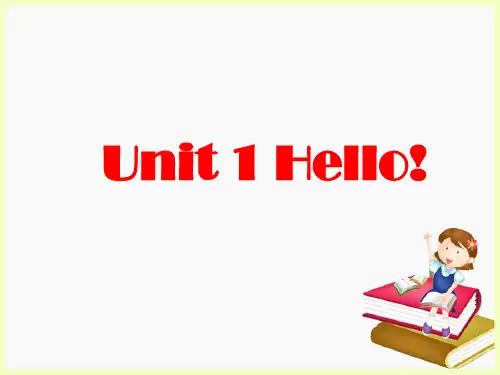
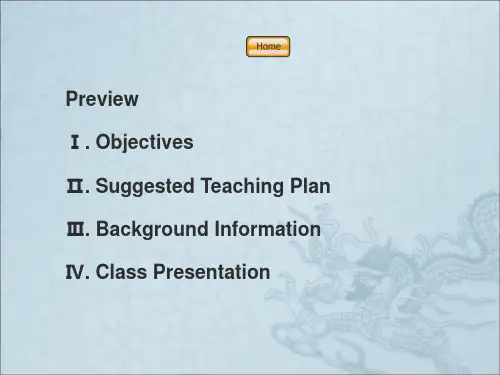
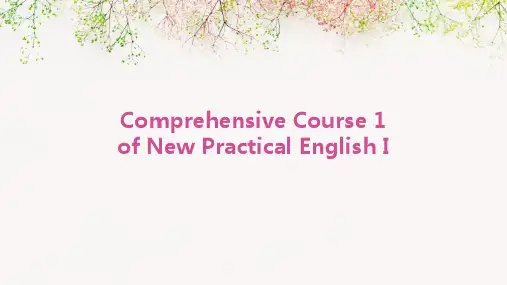
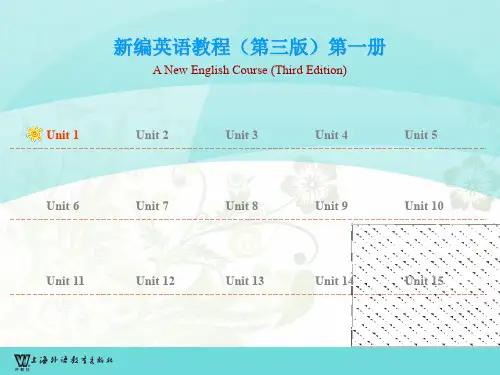
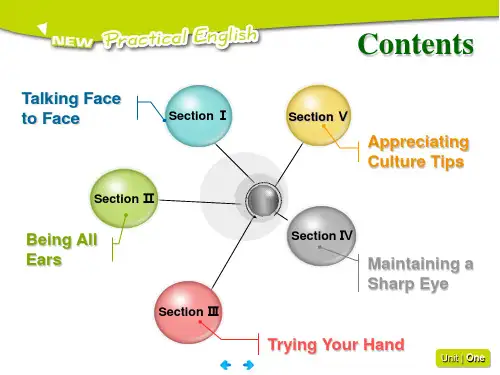
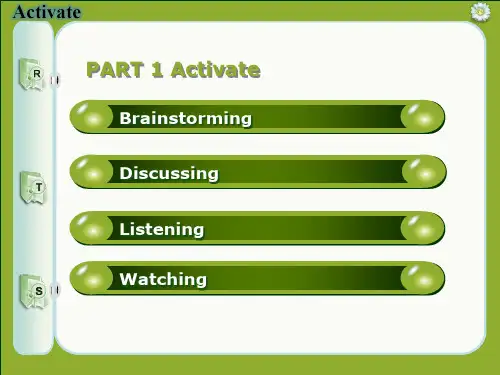

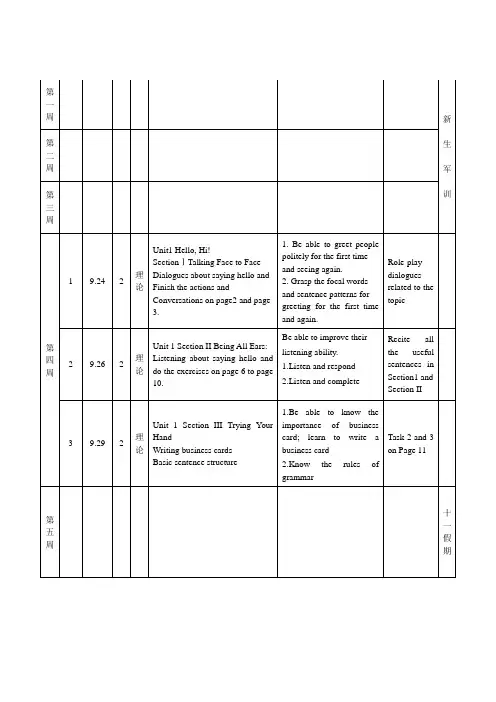
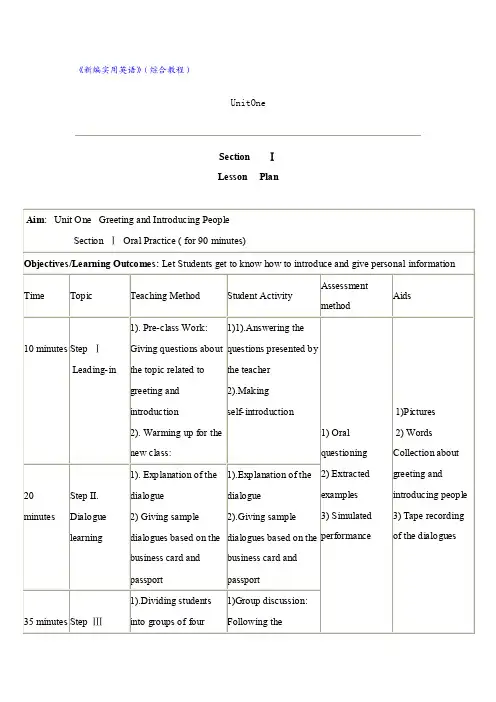
《新编实用英语》(综合教程)UnitOneSection ⅠLesson PlanContent: Section ⅠTalking face to faceAim: The topic area of Taking Face to Face in this unit is to talk about greeting people and introducing with each other. The focus of functions is to Let Students get to know how to introduce and give personal informationImportant and difficult points:Procedure and methods:Step I. Leading-in1. Pre-class Work: Giving questions about the topic related to greeting and introduction2. Warming up for the new class3. Student Activity:1).Answering the questions presented by the teacher2). Making self-introductionStep II. Dialogue learning1. Explanation of the dialogue2. Giving sample dialogues based on the business card and passport3. Student Activity:1). Listening to the tape recording of the dialogues2).Pair work: Learning the dialogues by heart and Reading out the dialogues loudly in pairs.Step ⅢActing outAfter learning the five dialogues on the book1 Dividing the students into groups of four or five2 Offering more situations for students to make dialogue3 Summarizing this part4 Student Activities:1).Group discussion: Following the dialogue and making dialogues based on the given situations2). Comments on classmates’performanceStepⅣPutting in use1. Completing and checkingInstructions: Ask students to work in groups to complete by filling in the blanks on Page 4, and then check the answers in class.2. RespondingInstructions: Ask students to practice Exercise 2 on Page 4 of the textbook orally . Offer the situation in Chinese, and ask students to give the English version, the whole class works together. After each activity, check the answers and make comments promptly.Section ⅡLesson planSection ⅡListening Practice (for 90 minutes)Objectives/Learning Outcomes: Correct understanding of the listening material about greeting and introducing peopleTime Topic Teaching Method Student Activity AssessmentmethodAids20 minutesStep ⅠListeningand decodeListen andrespond1) Introduction of listeningcomprehension2) Explanation of the dialogueand comments1) Choosing the rightwords they hear2) Answering thequestions based onthe dialogue theyhear1) Questioning thestudents withsome words andphrases relatedwith the listeningmaterial2) Distinguishingsound -similarwords3) SimulatedperformanceTaperecording ofthedialogues15 minutes Step II.Listen andcompleteListen andjudge1) Introduction of somelistening skills: How to catchthe information you need2) Checking the answers1) Listening to thedialogue2) choosing the rightanswer for themultiple choiceexercises40 minutes Step ⅢListen andreadListen andmatch1).Explanation of the keywords2).Explanation of the listeningmaterial3).Checking the answers1) Filling in theblanks with thewords they hear2) Matching theinformation incolumn A withchoices in column B3) Writing out thegeneral idea of thepassage byContent: Section ⅡBeing All EarsAim: Make the students master more useful vocabulary phrases and sentences to express themselves in English .when they meet people and introduce with each other. Important and difficult points:1. Introduction:Listening comprehension is the receptive skill in the oral mode. When we speak of listening what we really mean is listening and understanding what we hear.In our first language, we have all the skills and background knowledge we need to understand what we hear, so we probably aren't even aware of how complex a process it is. Here we will briefly describe some of what is involved in learningto understand what we hear in a second language.2.Listening Situations:There are two kinds of listening situations in which we find ourselves:·Interactive·non-interactive.Interactive listening situations include face-to-face conversations and telephone calls, in which we are alternately listening and speaking, and in which we have a chance to ask for clarification, repetition, or slower speech from our conversation partner. Some non-interactive listening situations are listening to the radio, TV, films, lectures, orsermons. In such situations we usually don't have the opportunity to ask for clarification, slower speech or repetition.Listen for main ideas. The main ideas are the most important points the speaker wants to get across. They may be mentioned at the start or end of a talk, and repeated a number of times. Pay special attention to statements that begin with phrases such as "My point is..." or "The thing to remember is..."Give your full attention on the person who is speaking. Don't look out the window or at what else is going on in the room.Remember: time is on your side! Thoughts move about four times as fast as speech. With practice, while you are Listening you will also be able to think about what you are hearing, really understand it.Procedure and methods:Step ⅠListen and decode & Listen and respond1. Introduction of some listening skillsInstructions: Help students get to know how to distinguish sound-similar words.2. Explanation of the dialogue and commentsInstructions: In this part students must choose out the words they hear from the tape recording. After playing the tape twice, check their answers.3. RespondingInstructions: After listening to the tape for the third time, students are asked to answer the questions listed out in the textbook orally.Step II. Listen and complete & Listen and judge1. Completing after listeningInstructions: Ask students to fill in the blanks with the words they get from the tape recording after hearing it for twice.2. Judging after listeningInstructions: After students listen to the same dialogue for the third time, ask them to choose the correct answers to the given sentence.Step Ⅲ.Listen and read, Listen and match1. Explanation of the key wordsInstructions: Students are going to hear a passage with some blanks for them to fill in. Before playing the tape recording, explain some key words which will appear in it. Ask students to memorize these words.2. Explanation of the listening materialInstructions: After students finish the filling-in, explain some difficult language points in the passage.3. Matching after listeningInstructions: In this part a dialogue will be given to each of the students, after they listen to it, they are asked to match the information in Column A with the choices in Column B. Then check their answers.4. Answering questions after listening to the passage again.Instructions: In this part the students are asked to write out the general idea of the passage in one paragraph by answering some listed questions in the textbook.Step Ⅳ. Listen and conclude1. Exercises in the workbookInstructions: Give explanations to some new words in the workbook, and ask students to finish the exercises in it, then check their answers.Asking students to memorize the new words which appear in the textbookSection ⅢLesson PlanTime Topic TeachingMethodStudent ActivityAssessmentmethodAids5minutes Step ⅠLeading-in1) Revision2) Thebackgroundinformationabout thepassage3) Warming upfor the newpassages1) Reciting somesentences theyhave learned inthe previous class2).Makingself-introduction1) Oralquestioning2) Extractedexamples3)Simulatedperformance1) Mapsof theweatherforecast2)WordsCollectionaboutweather3)Taperecordingof thedialogues35 minutes Step IIComprehensionof the passage1) Textpresentation andlanguage points2) Asking somequestions aboutthe passage3) Summarizingthe passage1) Listening tothe tape recordingof the passage2) Answering thequestions3) Retelling thepassage in a fewword20 minutes Step ⅢFurther exercise1) Conductingstudents to finishthe exercises onpage 102) Explanation ofthe difficult partsof the exercise3) Checking the1) .Finishing theexercise on page102).Learning theusage of somekey wordsContent: Section ⅢReading Comprehension“Maintaining a Sharp Eye”. The students will first read the two useful passages of "The way Americans Greet" and "A little About Me". The teacher will interpret the new words and structures in detail. Finally help the students do the exercises.Aim: Master the key words and structures, and learn something about the way American great This will give them an idea of how to greet foreigners especially American and how to introduce themselves.Important and difficult pointsProcedure and methods:Step I. Leading in1. Revision of the previous lesson2. Warming up for the new passages3. Student Activity:1).Reciting some sentences they have learned in the previous class2).Making self-introductionStep II Comprehension of the passage1.Explanation of the new words and language points in the passageA. Important Words and PhrasesInstructions: Give some examples to explain the difficult words. Ask students to make sentences with the words they just learn.1). greet: v. say words of welcome to, express one‘s feelings on receiving sb. 问候,致意,打招呼e.g.: It is important for the students to learn how to greet people in English.The American professor greets his students with “Morning!”2).relationship:n. particular connection or relation; instance of being related 关系,联系e.g.: He is making efforts to develop a lasting relationship with Lizzy.3).wave: v. move one‘s hand to and fro, up and down (to give a greeting or say goodbye) 挥手致意,舞动e.g.: Jean waved goodbye to her Chinese friends,4). leave: v. go away from; fail or neglect to take/bring sth. 离开,出发;留下,遗忘e.g.: The beautiful city has left a deep impression upon our mind.5).impression: n. effect produced on the mind or feelings 印象e.g.: His speech made a strong impression upon the audience. 他的演说给听众留下了深刻的印象。